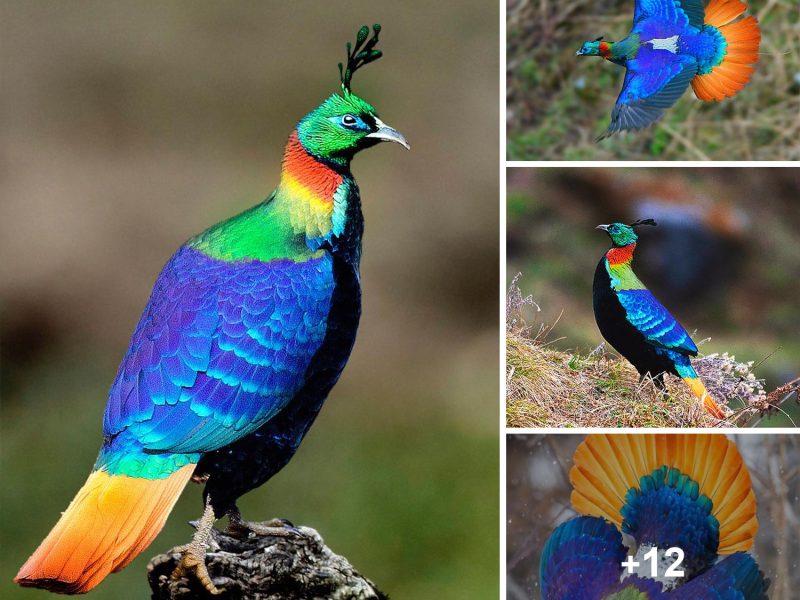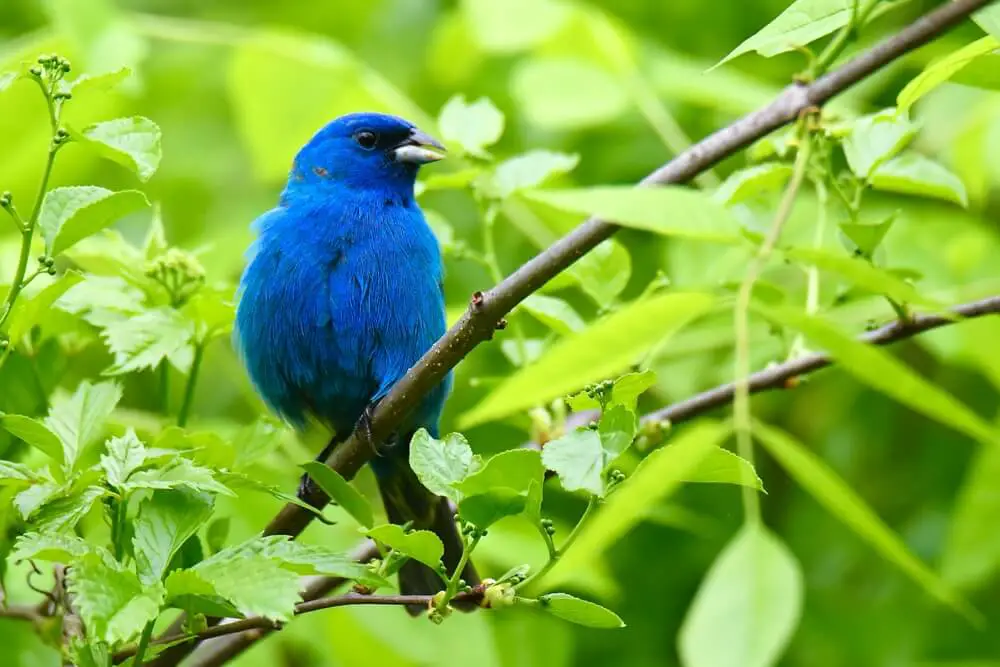
The strikingly blue indigo bunting is an abundant songbird that is a sight to behold and wonder to hear.
Males are the only ones to sing, and they each have a unique song. Males also share a song with other indigo buntings in their neighborhood, crafting a song unique to their area together.
Interestingly these birds migrate at night using star navigation. They travel over a thousand miles to reach their wintering grounds.
Read on to learn more about these beautiful blue birds.
1. Indigo Buntings Use The Stars To Migrate At Night
Indigo buntings have an “internal clock” that orients them to stars as they migrate.
Using stars for navigation allows the birds to fly over a thousand miles and to stay the course.
They choose a star to determine their location in space and maintain an angle between the star and earth. This assists them to fly in a direct line to their destination.
The majority of migration occurs in late September. Indigo buntings are considered long-distance migrants. Some travel 1,200 miles one way from breeding grounds to wintering areas.
They leave eastern North America for winter in southern Florida and northern South America.
2. Only Male Indigo Buntings Sing
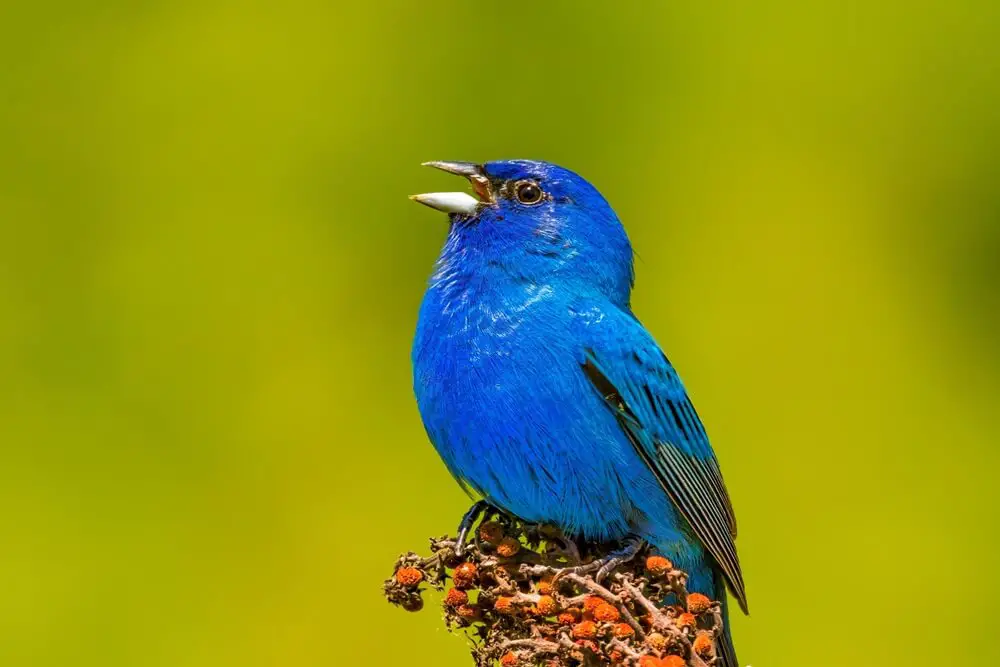
Males are the only ones to sing. They each have their own complex song for use during the breeding season. These birds are affectionately nicknamed “blue canaries” by some bird watchers.
They perch and make themselves visible to other males, females, and potential predators, singing away.
Their songs consist of whistling, lively, sharp, high-pitched doubly-repeated notes. These notes last up to 2 seconds.
A male can sing as many as 200 songs hourly during dawn, and then sings about 1 song per minute for the remainder of the day.
While females do not sing, they make calls that are short, 1-syllable “spit”, “zeep”, or “chip” sounds.
Check out this video of an indigo bunting singing:
3. Males Learn To Sing From Other Males
Young indigo buntings learn to sing from other males in their “neighborhood”. Generally, they do not learn to sing from their fathers.
These songs are taught and long-lasting for up to 20 years, much longer than the average lifespan (10 years) of an indigo bunting.
4. They Develop Neighborhood-Specific Songs
Indigo buntings produce nearly identical songs as others in their “neighborhood”. Buntings a few hundred yards away will have different songs.
As time goes on, the neighborhood song may change as new males add in variations.
Indigo buntings are often spotted perched and singing in sight in the summer in rural areas along roads, telephone wires, and wooded edges.
5. Males’ Feathers Lack Blue Pigment
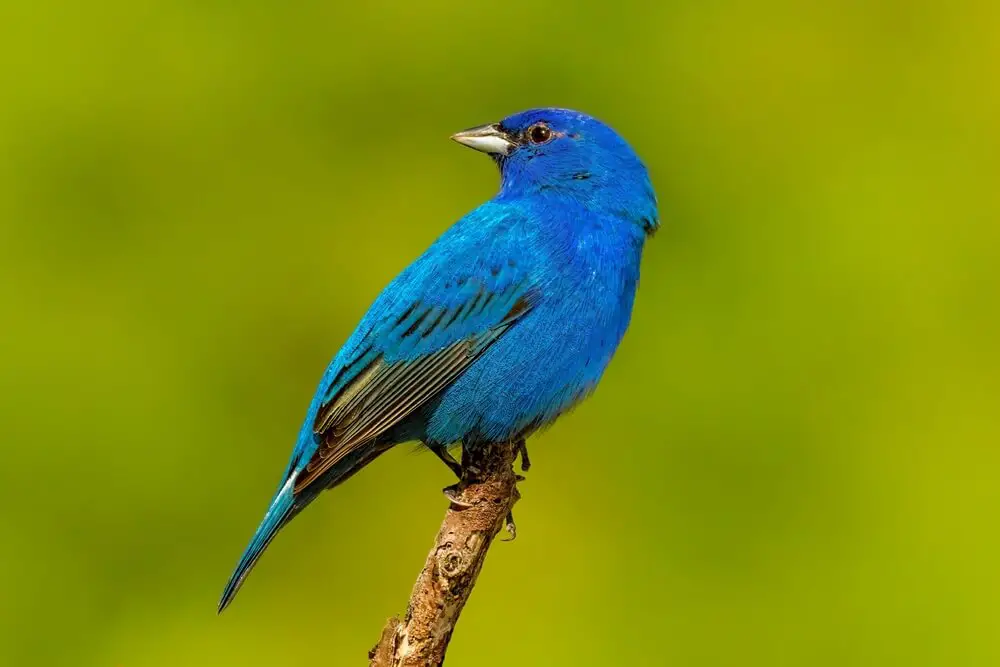
Like other blue birds, the indigo bunting’s feathers lack blue pigment. Their beautiful cyan-blue tones result from the reflection of blue light (just like the blue sky).
Microscopic structures within the feathers reflect the light in such a way that we see blue. Their heads may look slightly darker blue than the rest of their bodies.
Females are much different than males in their coloration. Year-round they are brown with a white throat. They may have a light touch of blue on their wings, tails, or rumps.
Juvenile males are patches of brown and blue.
6. Males Are Only Blue During A Part Of The Year
Surprisingly, males are only blue during the breeding season (spring and summer). They molt in other seasons so that they present with brown plumage mottled with accents of blue.
Indigo buntings are this brown and blue coloration when they migrate south and are not likely to be seen this way in most of the United States.
7. Indigo Buntings & Lazuli Buntings Interbreed & Share Songs
The indigo bunting (Passerina cyanea) and lazuli bunting (Passerina amoena) are closely related.
Their ranges overlap in the Great Plains, and as a result, they have interbred with each other to form a hybrid species (Passerina amoena x cyanea).
These two species will also fight each other to defend territories as well as share and create neighborhood songs.
8. The Breeding Season Is In Only Parts Of The United States
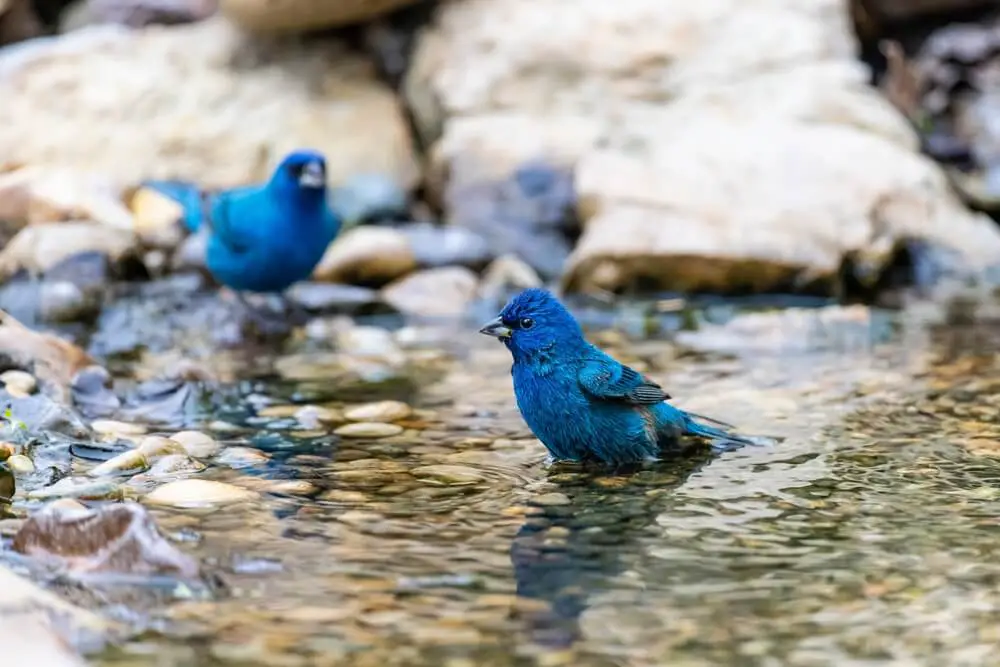
Indigo buntings prefer to breed in moist areas with brush and weeds. They are also commonly found in logged forest plots, bushy canyons, and abandoned fields.
They nest and live along woods and field edges, roads, streams, and rivers.
These birds are spotted in the southwestern and eastern United States in the spring and summer breeding seasons. Typically, they are found from Florida to Maine, and west to North Dakota and Texas.
Their range is showing signs of southwestern expansion with sightings in the Four Corners of Colorado, Utah, Arizona, and New Mexico.
9. They Are Not Typically Found In Urban Areas
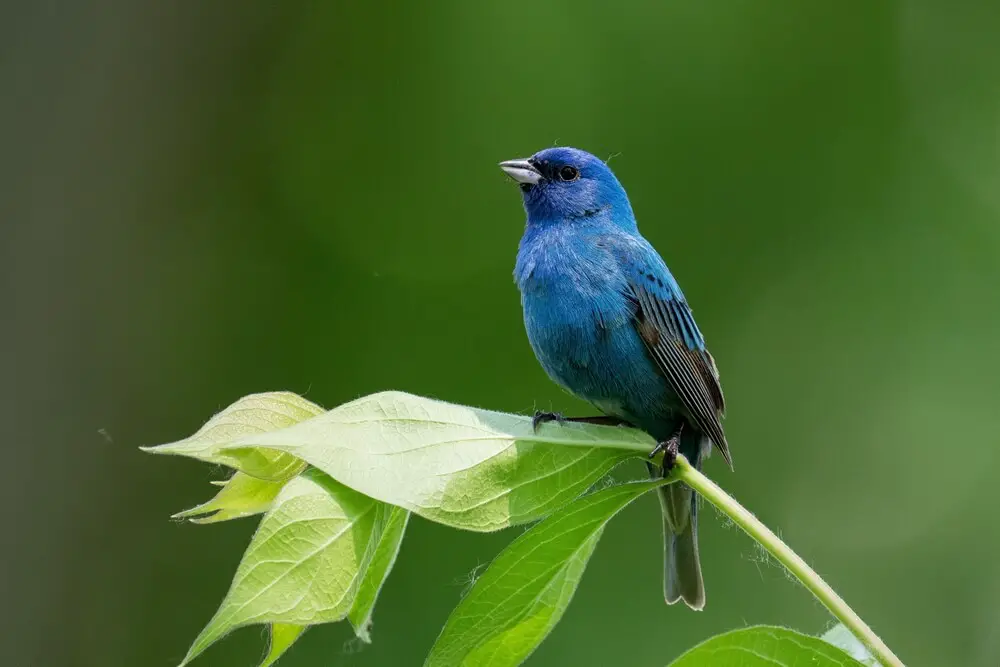
Indigo buntings are not typically found in urbanized areas since these birds love brushy areas such as pastures and wooded edges.
When they migrate to the tropics in the winter, they tend to still prefer brushy areas, such as the edges of farm fields.
10. Indigo Buntings Visit Bird Feeders & Vary Diet By Season
An indigo bunting may visit a bird feeder if it offers thistle, nyjer, or mealworms. An indigo bunting may be hesitant to visit a busy feeder, but it may eat seeds from it if it is placed close to the edge of a bushy area.
However, spiders and insects are the main source of food during the summer and are what is offered to hatchlings.
They have an omnivorous diet which includes foods such as berries, insects, spiders, small seeds, grains, and buds. They hop along the ground foraging and gleaning insects off of low vegetation.
11. They Are More Social In The Winter
In the summer, indigo buntings typically forage for insects alone. However, in the winter, they will flock together to forage for seeds and seek nutrient-dense food sources.
As they migrate, large flocks of these birds will stop at fields, grasslands, shrubs, trees, and lawns to forage.
12. Males May Have More Than One Mate
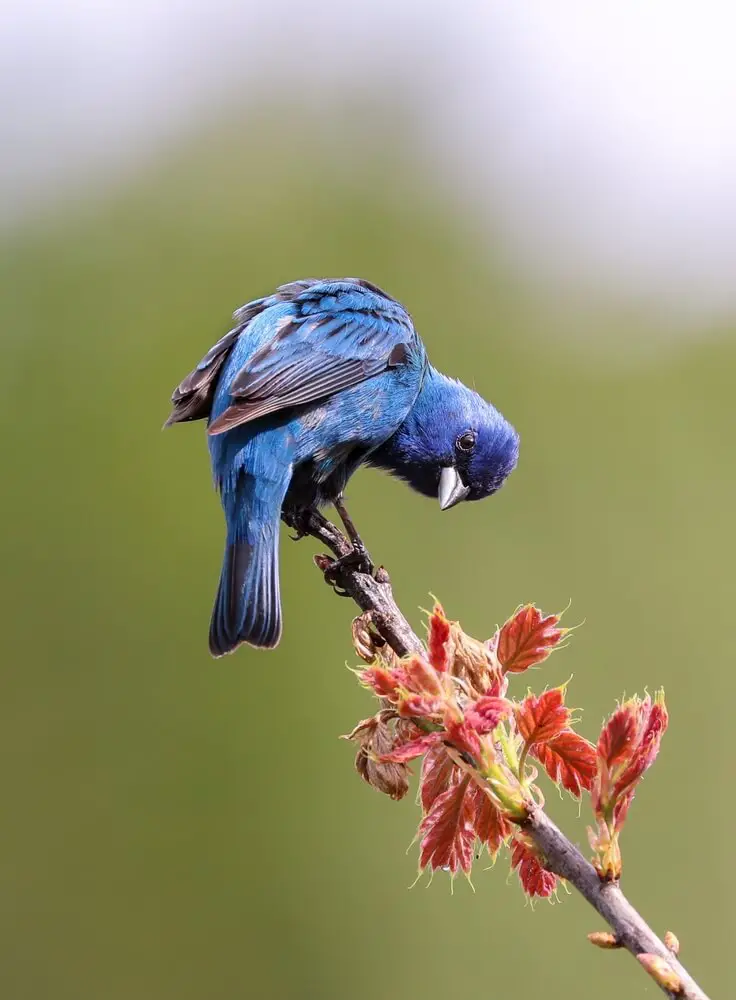
Males may have more than one mate on their territory each breeding season. He invites females in with his song.
This may include lazuli buntings in overlapping areas as discussed above.
13. The Female Builds The Nest & Wraps It With Spider Web
The female indigo buntings build a nest site only 1 to 3 feet above the ground.
These nests are constructed in dense shrubbery or a low tree along the edges of woods, railroads, or roadsides. The male may watch her but does not assist.
Their open cup-shaped nests are nestled in forked branches and made of weeds, grass, leaves, and bark. It is lined with slender grasses, rootlets, thistledown, and deer hair and wrapped with spider webs.
It takes the female 2 to 8 days to build the nest which is 1.5 inches deep and 2 to 3 inches in diameter.
14. Females Incubate The Eggs On Their Own
Females are not often readily seen since they are busy incubating and caring for their eggs and nestlings. Their nests are hidden away, low in shrubbery and dense vegetation.
Females lay 1 to 3 broods of eggs with 3 to 4 eggs each time during the breeding season.
Occasionally, a male may help feed the nestlings if the female goes off to build another nest for another brood. The nestlings leave the nest 9 to 12 days after hatching.
15. Males Use Various Tactics For Defending Their Territories
Male indigo buntings will approach each other with a slow butterfly-like flight. They hold their wings in a right-angled position.
They will even sing while they fight to defend their territory, grappling claws with one another.
Additionally, a male may also fly to the top of a shrub, raise its crest feathers, and swing its tail from side to side.
16. Their Lives Are Negatively Impacted By Human Activity
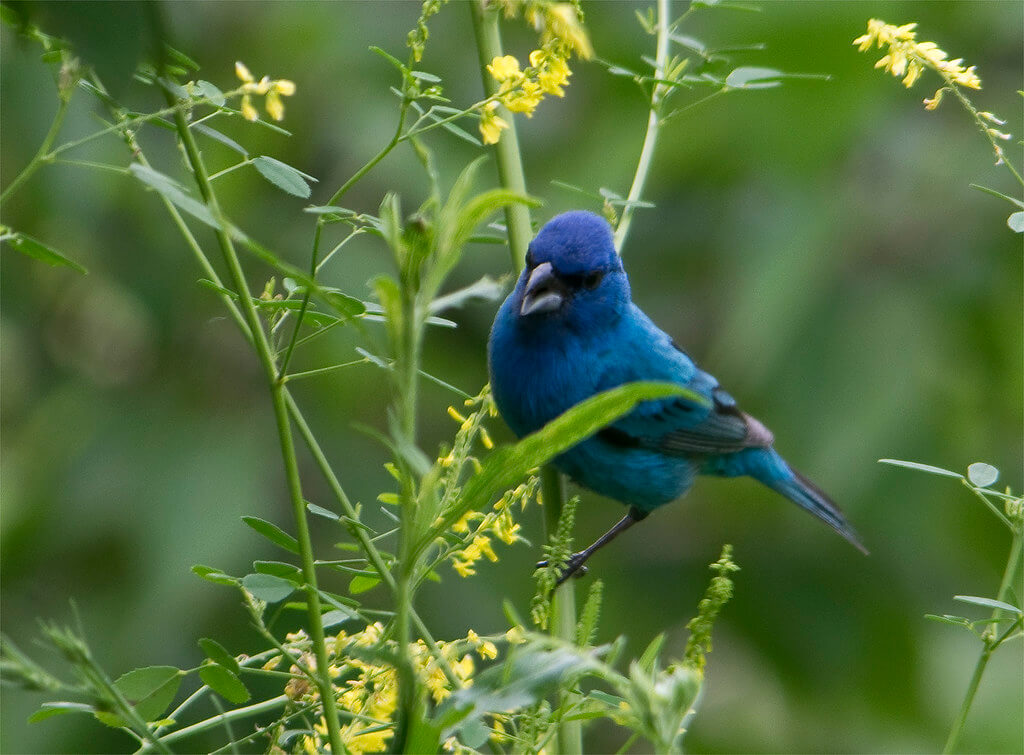
Indigo bunting populations are at risk of decreasing, due to practices that remove dense vegetation and shrubbery. This includes agricultural practices, reforestation, mowed roadsides, and fields, and increases in urbanization.
The males’ bright blue feathers make them prized birds for illegal trapping and hunting.
Indigo buntings also suffer from accidental deaths during migration. This happens when they collide with buildings, vehicles, and transmission towers.
On average, indigo buntings can live up to 10 years in the wild, and the oldest recorded was over 13 years old.
Conclusion
Male indigo buntings steal the show with their unique songs and brilliant blue coloration.
Indigo buntings are most often found in rural areas or areas with dense vegetation and shrubbery. They use the stars to navigate their way to wintering grounds.
These facts and more make the indigo bunting a bird to add to your “watch” list.

